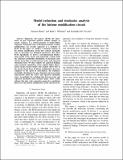Model reduction and stochastic analysis of the histone modification circuit
Author(s)
Bruno, Simone; Williams, Ruth J.; Del Vecchio, Domitilla
DownloadAccepted version (1.217Mb)
Open Access Policy
Open Access Policy
Creative Commons Attribution-Noncommercial-Share Alike
Terms of use
Metadata
Show full item recordAbstract
Epigenetic cell memory (ECM), the inher-itance of gene expression patterns without changes in genetic sequence, is a critical property of multi-cellular organisms. Chromatin state, as dictated by histone covalent modifications, has recently appeared as a mediator of ECM. In this paper, we conduct a stochastic analysis of the histone modification circuit that controls chromatin state to determine key biological parameters that affect ECM. Specifically, we derive a one-dimensional Markov chain model of the circuit and analytically evaluate both the stationary probability distribution of chromatin state and the mean time to switch between active and repressed chromatin states. We then validate our analytical findings using stochastic simulations of the original higher dimensional circuit reaction model. Our analysis shows that as the speed of basal decay of histone modifications decreases compared to the speed of autocatalysis, the stationary probability distribution becomes bimodal and increasingly concentrated about the active and repressed chromatin states. Accordingly, the switching time between active and repressed chromatin states becomes larger. These results indicate that time scale separation among key constituent processes of the histone modification circuit controls ECM.
Description
2022 European Control Conference (ECC), London, United Kingdom, 2022
Date issued
2022-07-12Department
Massachusetts Institute of Technology. Department of Mechanical EngineeringJournal
2022 European Control Conference (ECC)
Publisher
IEEE
Citation
S. Bruno, R. J. Williams and D. Del Vecchio, "Model reduction and stochastic analysis of the histone modification circuit," 2022 European Control Conference (ECC), London, United Kingdom, 2022, pp. 264-271.
Version: Author's final manuscript